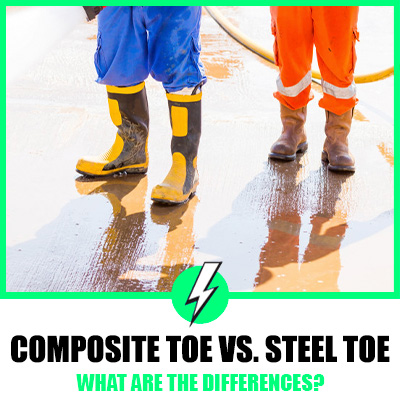Composite Toe Vs. Steel Toe
There is no doubt that personal protection equipment or PPE features high on tradesmen’s basic requirements. They add an element of protection and make the job more comfortable. Your employer might also require you to wear a safety boot, mandatorily while on site. Besides, wearing proper PPE is a legal requirement for electricians in the UK.

More than any other job, PPE for electricians can mean the difference between life and death. Of course, this is not to undermine its importance for our comrades in different trades in any way.
For the feet, a safety boot is a gold standard for electricians. And among the most popular safety boots are the composite boot and the steel toe boot. These boots come with protective toecaps and are penetration-resistant. Also, these boots also have electric conductivity, which is paramount for an electrician.
But since the boots have many fans on both sides, today we compare the two boots. Let’s dig into the features of the boots and see how they measure up against the other.
Contents
Here is the ultimate battle of composite toe Vs steel toe boot
The material of the boots
The primary materials in the toe area of composite boots are non-metal. This includes such materials as carbon fibre, fibreglass, Kevlar, and sometimes plastic. These materials cannot replicate the sturdiness of steel. However, they are pretty strong and can stand their ground.
On the other hand, steel toe boots have a piece of steel in the toe area. The boots also consist of other materials such as leather and rubber, similar to other boots.
Design
Composite boots typically come in one design and toe style. The infamous comp toe is instantly recognizable by the bulbous and rather puffy shape of the toe. This design is by no means aesthetically elegant. However, this design is necessary for a good reason. It accommodates the thick layers of the composite materials so that the boot meets the safety regulations.
The only exception is a composite toe with carbon fibre. Carbon fibre is not as thick as other materials, so the shoes tend to be less bulky.
Steel toe boots have a more elegant style and toe designs. Of course, even the slimmest steel toe shoe will not be as stylish as a dress shoe. So it’s good to maintain reasonable expectations. In terms of style options and sizes too, steel toe boots offer more variety to the customers.
Protection
Composite toe boots offer excellent protection from the elements due to their resistance to ambient temperature. The plastic and other composite material also act as thermal insulators making it the right choice for cold climates. Also, they have the advantage of electrical conductibility and anti-staticity, making them an excellent choice for electricians. If you choose a composite boot, you still need to make sure that it is Electrical Hazard rated.
However, composite boots cannot withstand impacts like a steel toe boot. They are, of course, up to the latest safety standards.
Steel toe boots take the trophy for handling impacts like a champ. They are designed to withstand thousands of pounds of pressure. Top of the line steel toe boot can protect your foot from up to 2,500 lbs of compressive loads, which is impressive.
Comfort
No matter how fancy or innovative a boot is, nothing comes close to a comfortable pair. Composite boots are the winners when it comes to comfort, so you can quickly wear them for the whole day. It is due to a combination of breathability and lightweight property. A composite toe boot is about 30% times lightweight than a steel toe boot. Besides, composite boot manufacturers incorporate superior technology in the boots, making them even more comfortable.
The steel component in the steel toe inherently adds some weight to it. This seemingly little ounce may be insignificant in the morning. However, it can considerably weigh down your feet by the end of the day. Furthermore, steel toe boots are not breathable, which can be a challenge to wear for some folks. In inclement weather, these types of boots will not give you protection as well.
Convenience
Among the top reasons that composite boots lovers cite over a steel toe is the convenience. Wearing composite boots to areas where you have to pass through a metal detector without setting it off is considered a great advantage.
However, some composite toe boot that comes with a metal shank can also set off the metal detectors.
Steel toe boots are infamous for setting off metal detectors, which many people consider a great inconvenience. The myth about a steel toe boot damaging the wearer’s feet in the event of an impact also deters a good number of people. This is not true at all. Steel toecaps might flatten in case of a crash. However, it will not crimp backwards or shred as the myth describes.
Price
When it comes to the price, composite boots carry a higher price tag. Composite boots are a relatively new development and are continually changing. In addition, some composite materials cost more than traditional materials, which kicks up the overall cost of this work boot.
Steel toe boots are comparatively cheaper than their newer counterparts. The traditional design remains relatively unchanged, which has allowed the boot to have a consistent price tag throughout the years. The steel toe boot’s initial design from the 1940s is still in circulation, with slight tweaks here and there.
Wrapping up
As we see throughout the composite toe vs steel toe boot comparison, both have their pros and cons.
Ultimately, the choice of safety boot comes down to the nature of your job. However, as a team of professional electricians, we prefer the composite boot. It is light enough to wear all day, offers adequate protection and comfort. Yes, it is a little pricey. But nothing is too much where personality safety is concerned. But that is just our humble opinion.





